SKOPJE - THE CAPITAL OF MACEDONIA
:: GEOGRAPHIC POSITION :::..
Skopje (also known as Skoplje, Shkupi, Uskub, Skopia) is the capital and the largest city of the Republic of Macedonia. It's located in the north-western part of the republic and it's 169 km away from the second largest city in Macedonia, Bitola. It lies on the both banks on the upper course of the Vardar river and on the meridian passing through the Morava-Vardar valley. Near the city passes the main Balkan artery, the E-75 motorway, which is being modernized. This road connects Skopje with Belgrade (440 km away) and Solun (Thessaloniki) and the Aegean sea (250 km) in the eastern Mediterranean. Skopje is just 647 km away from Athens, from Sophia (Sofija) 170 km & from Bucharest 460 km away.
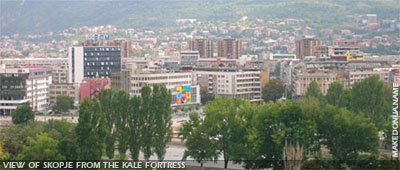
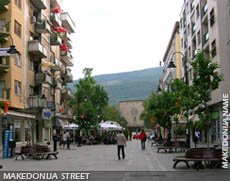 Many other communications that lead to Skopje or pass through it branch off this road. Surmounting the gorge of Kačanik, one road leads to the Serbian province of Kosovo, and continues on to the blue and wonderful Adriatic Sea. This road begins in Skopje, passes by Priština, Kosovska Mitrovica, leads through Rožaj, Podgorica to the Montenegrin coast and brings Skopje closer, just 400 km to the Adriatic coast. Skopje's location is not important only now, it also has a great future importance. This town has always been an administrative, cultural, political and traffic centre. The strategic importance of Skopje's geographic position was noted long ago in the maps of all the conquerors whose appetites spread to this valley, both in direction of the Aegean and the near East, and also in the opposite direction, to the north.
Many other communications that lead to Skopje or pass through it branch off this road. Surmounting the gorge of Kačanik, one road leads to the Serbian province of Kosovo, and continues on to the blue and wonderful Adriatic Sea. This road begins in Skopje, passes by Priština, Kosovska Mitrovica, leads through Rožaj, Podgorica to the Montenegrin coast and brings Skopje closer, just 400 km to the Adriatic coast. Skopje's location is not important only now, it also has a great future importance. This town has always been an administrative, cultural, political and traffic centre. The strategic importance of Skopje's geographic position was noted long ago in the maps of all the conquerors whose appetites spread to this valley, both in direction of the Aegean and the near East, and also in the opposite direction, to the north.
Skopje is situated on an altitude of 255 meters above the sea level and lies in the Skopje valley. The eastern exit from the valley connects it with Ovče Pole (besides Pelagonija, the second granary of Macedonia) and the Kumanovo-Preševo valley. Several mountains rise above the city on the other side, sheltering it under their peaceful leeward slopes. To the south the natural border if the Skopje vicinity is the Vodno mountain with the peak Krstovar (1,066m), which extends on to the Jakupica-Karadzica mountain range, whose highest top is Solunska Glava (2,540m), with a view of Solun (Thessaloniki) and the Aegean Sea. To the south-west, the Skopje valley stretches to mountains Osoj (1,506m) and Žeden (1,260m), in the directions of the white tops of the Šar Mountain. On the north, the Skopska Crna Gora mountain rises above the Skopje valley with it's highest peak Ramno (1,561m), whose easily accessible slopes are dotted with inns for excursionists. The Vardar river enters the Skopje region at the Derven canyon, north-western and leaves at the Taor canyon south-eastern of the city.
:: HISTORY OF THE CITY :::..
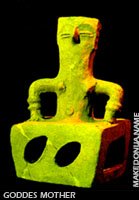 Skopje was mentioned for the first time by the Greek geographer Claudius Ptolomeius, under its ancient name Scupi in the 3rd century BC. It was located at the confluence of the rivers Lepenec and Vardar. Here the archeologists discovered Scupi, just 5 km from the center of the city, in the vicinity of the Zlokukjani village. In this period, the city experienced real bloom on several fields, it became a large religious center with its own bishop. According to the scientists, in the ancient times Scupi was taken the Trybals and later in was controlled by the Dardans, who were an Illyrian tribe. In the year 148 BC, the Romans came to the Balkans, conquered Scupi and settled the Roman army here. After that the city flourished not only as an economic, strategic and cultural centre, but also as a religious centre, to which Christianity spread very early. It became a large religious center with its own bishop. Later on the frequent barbarian raids were not the only troubles of this town. Scupi was almost completely destroyed by an earthquake in 518 AD, the first of the three disastrous earthquakes that leveled this city. In his chronicle Comes Marcelinius described this tragedy:
Skopje was mentioned for the first time by the Greek geographer Claudius Ptolomeius, under its ancient name Scupi in the 3rd century BC. It was located at the confluence of the rivers Lepenec and Vardar. Here the archeologists discovered Scupi, just 5 km from the center of the city, in the vicinity of the Zlokukjani village. In this period, the city experienced real bloom on several fields, it became a large religious center with its own bishop. According to the scientists, in the ancient times Scupi was taken the Trybals and later in was controlled by the Dardans, who were an Illyrian tribe. In the year 148 BC, the Romans came to the Balkans, conquered Scupi and settled the Roman army here. After that the city flourished not only as an economic, strategic and cultural centre, but also as a religious centre, to which Christianity spread very early. It became a large religious center with its own bishop. Later on the frequent barbarian raids were not the only troubles of this town. Scupi was almost completely destroyed by an earthquake in 518 AD, the first of the three disastrous earthquakes that leveled this city. In his chronicle Comes Marcelinius described this tragedy:
"... In just a moment 24 towns were destroyed. Scupi, the capital of Dardania, was leveled completely as if it had been sacked by the most terrible conquerors. A crack of 30 miles long and 12 feet wide appeared, gushing hot stream."
Wonderful architectonic buildings, numerous public baths, temples and the ancient amphitheater built in a roman style, large basilica with mosaic floors have completely disappeared from the earth’s face. Since then Scupi is not mentioned any more. Archeological excavations show life continued in the north-eastern part of this Roman city, later in the 6th century.
During the Byzantine Emperor Justinijan 1st, the Skopje valley got a new city center called Justinijana Prima, after it's founder the Emperor Justinijan, whose family was from the Taor village (in the vicinity of Skopje). During Justinijan 1st, Slavs started to invade these areas. As defense Črni Castle was built on the foothills of Vodno mountain. By the end of the 6th century, in front of the ramparts of the city the Slavic people have showed up and the Slavic tribe Beregeziti (also known as Berziti), managed to conquer the city in 695 AD and later gave the new name - Skopje. The native inhabitants were mostly slaughtered or driven away and some were gradually assimilated. This same tribe was later recognized as the rulers of the territory between Skopje and Ohrid. The next three centuries there are no written documents about Skopje.
The end of the first millennium brought the first Macedonian state and the Macedonian Emperor Samoil (976-1014). In this period 10th-11th century, the city continued to develop. Merchants from Samoil's empire spread their trade to neighboring cities, both to the north and to the south, along the Adriatic coast and Dalmatia. Skopje retained its prestige although it was neither capital nor administrative centre. During the reign of Samoil, Skopje was commanded by a Roman who returned from Constantinople. Later on in 1004, during a battle between Samoil's soldiers and the Byzantine, he betrayed the city to the Byzantine Emperor Vasilius 2nd. The tragic end of the Emperor Samoil at the Belasica battle in 1014 brought hardship back to Skopje.
After the fall of the Macedonian Empire the city again gained strategic importance and got various titles. The populations of this district tried many times to show their revolt against the conquerors by taking up arms. In 1040 there was the rebellion of Petar Deljan, nephew of the Emperor Samoil. He fought very bravely for Skopje and Macedonia and he even succeeded in returning the city, but only for a short period. The next rebellion was in 1072, led by Georgi Vojteh. But his success only lasted for a short period also. In 1081 Skopje got a new master. The Normans, led by Robert Guiscard, arrived via Durres (city in Albania) and attacked and sacked Skopje. They ruled for 7 years
In 1093 the tribal head of the Serbs, Vukan, interrupted the domination of the Normans for a short period, and then the Norman Duke Boemund Tarenian again subjected the whole of Polog valley, including Skopje. Many conquerors followed him in the streets of this city. The first of them was the Bulgarian Emperor Kaloyan (1204). Three years later the master of Prosek, Dobromir Strez, arrived in Skopje and remained until 1215. After him again the Bulgarians, Byzantines, the Serbs. The fate of Skopje was similar to the fate of Macedonia: constantly to change masters. The emissary of the Byzantine court, Theodor Matohit, wrote about Skopje in 1299:
"Under the town ramparts there is also a suburb with the most beautiful cathedral I have ever seen in these regions."
Once again in its rich history Skopje became a capital, this time of the mighty Serbian state of Dušan Stefan. Dušan was crowned Emperor in Skopje in 1346. Another important event took place in 1349: Dušan's Legal Code was proclaimed. These events made the city very important not only as political, but as a cultural and trading centre as well. In 1392 Skopje fell under the Turks. An unknown monk from the Monastery of St. Theodor wrote:
"In the year of 69... when the Turks arrived in Skopje in the month of gonever..." (according to the new calendar this was January 19th, 1392)."
Since 1392 Skopje became Uskub, which was the Turkish name for the city. As time passed, its population increased fast thanks to the immigration of many Turkish families. And so Skopje again grew as an economic, and later also as a political centre. Up to 1453 Skopje was a throne of the Turkish sultans and later it developed in a significant craftsmen and commercial centre. Data show that already in 1469 it had a market place with many shops and a caravan-serai visited by many merchants and other travelers. In those days the city was known as an important slave-market. It is obvious that the slaves were Macedonians and the other non-Muslims - Armenians, Jews and so on. They were forced to settle in the deserts of Asia Minor, from where Turkish colonists emigrated and settled in Macedonia. Skopje was stricken by a new catastrophe in 1555. Another earthquake ruined many houses. The citizens, already accustomed to devastation and ruin, soon rebuilt the city, and a Venetian merchant wrote: "Skopje covers an area of 28 sq km with beautiful houses". The already mentioned Turkish writer Evliya Čelebi showing his enthusiasm, wrote:
"Skopje has 70 town quarters with 11,060 houses one or two storeys high. The houses are made of stone or of mud, but all covered with red tiles. The streets are clean and straight, paved, and the business district is full of Latins, Frenchmen, Hungarians and others. Around the city there are 77,000 dulums of private land as many vineyards owned by religious establishments."
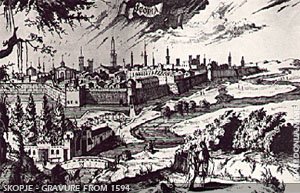
However, the Turkish poet Dilger Zede who visited the city in the 17th century, was really thrilled by the beauty and position of Skopje, said:
"I traveled for a long time across that country of Rumelija and I saw a lot of beautiful cities and I was amazed from the Allah's blessings, but not one has impressed and delighted meas that city of paradise - Skopje, through which the river Vardar flows."
Some historians say that in the period between 15th and 17thcenturies Skopje was one of the richest towns in the Balkans. All this was made possible in the first place because of its location, and the fact that the frontiers of the Ottoman Empire were very distant. Deep inside the Empire, Skopje was allowed to develop into an economic and crafts centre. According to some sources, in the wealth and size Skopje was the second town in the whole European part of Turkey. Most of its inhabitants were Macedonians, and so were the villagers on the hills of Skopska Crna Gora, where the Slavic way of life and ethnic characteristics could survive more easily. Bishop Marin Dichi from Bar wrote in 1604 that the city had about 200,000 inhabitants in over 40,000 houses. These numbers are certainly exaggerated, but nevertheless many travelers passing through the Balkans and Macedonian described Skopje as a "large town".
The defeat of the Turkish army in the 17thcentury under the walls of Vienna and its retreat before the Austrian army triggered off many Slavic rebellions in the Balkans. The first rebellion in Macedonia was in Kratovo in the year 1689 and was known as Karpoš rebellion. There, miners led by the legendary Karpoš, whom they named a "peasant king", were at first successful. They liberated Kratovo, Kriva Palanka and the region up to Veles, Demir Kapija. The rebels came near Skopje, but they were pushed back by the Turkish army which had in the meantime suffered several defeats at the hands of the Austrians. The Austrian general Picolomini and his army advanced to Skopje through Kosovo and the Kačanik Pass. This event was of great importance for the history of this town. Entering Skopje, Picolomini was amazed at his beauty. In his own hand he wrote:
"Skopje is spread over a large area and is only a little smaller than Prague. The town is surrounded by beautiful orchards in a large and rather fertile and well cultivated plain. It has almost 60,000 inhabitants, among them 2,000 Jews."
Picolomini captured the city on October 25th, 1689. An event with an outstanding significance for Skopje. His intention was not to continue southwards and take Macedonia, but to take Durres and Albania and to reach the sea. But to show the strength of his army and to destroy this important Turkish fortification he decided to burn down the city. Another reason for his decision was cholera epidemic that was raging in Skopje. From the hillsides of the Vodno mountain, Picolomini observed on the blaze:
"I decided, although it was not easily, to burn the town into ashes. I am sorry for the houses such as I have not seen at all in this war. The mosques are from the highest quality marble and porphyry, decorated with thousands lamps on a golden plated holders, which one would devote equal attention even in Rome. I feel sorry for the nice antiquities, gardens andpleasure grounds. All this I give to the flames so as not to leave the enemy anything he could put to use."
The fire was raging for two days and except the massive stone buildings, the city was completely destroyed. It was "ill" for a long time afterwards. Up until the half of the 19th century, the city could not recover back its previous appearance in front of which the numerous people who write about their traveling have stopped with a delight. Amy Bue, a French geologist traveling through Macedonia, noted that Skopje has 10,000 inhabitants. In 1836-1837, the first public Slavic school was opened in Skopje. In the same year, according to Amy Bue, the city had three schools in which geography, history and philosophy we taught. It is interesting that the Macedonian crafts guilds gave great financial aid to these schools. In thesecond half of the 19th century, the city becomes an important traffic center. It's population doubled. More than 60 different crafts were developed. Moving towards the countries from the middle east, Napoleon has found out the road through Skopje. A lot of merchants with their endless caravans loaded with various goods have been passing through the city. In this period the city reaches the biggest development of the handicrafts.
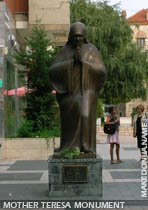 Later, Skopje begins to change its appearance. In 1872 the Skopje Archbishopric was finally separated from the Patriarchy of Istanbul. But instead of gaining independence, it was joined to the Great-Bulgarian Exarchy, which meant new danger from the penetration of another foreign propaganda in Macedonia (Greek already existed). A new chapter in the history of Skopje was the construction of the Solun (Thessaloniki)-Skopje railway in 1873. The city then became a modern railway town, confirming its importance as a traffic centre.
Later, Skopje begins to change its appearance. In 1872 the Skopje Archbishopric was finally separated from the Patriarchy of Istanbul. But instead of gaining independence, it was joined to the Great-Bulgarian Exarchy, which meant new danger from the penetration of another foreign propaganda in Macedonia (Greek already existed). A new chapter in the history of Skopje was the construction of the Solun (Thessaloniki)-Skopje railway in 1873. The city then became a modern railway town, confirming its importance as a traffic centre.
Due to the Internal Macedonian Revolutionary Organization activity in the Skopje region, only 528 persons were arrested in Skopje, after the great Vinica scandal.Skopje was an Ottoman city for 5 centuries, from 1392 to 1912. The two Balkan Wars (1912-1913) changed the situation in the Balkans, but nevertheless they did not bring freedom to Skopje, Macedonia or the Macedonians. Macedonia the largest Ottoman province, was divided between Greece, Bulgaria and Serbia, while small part were given to Albania. On October 12th 1912 the Turks were driven away from the city, but the Serbian army remained. Together with Skopje, the whole Vardar Macedonia remained under Serbian dominance. The Treaty of Bucharest from 1913 decided the fate of the Macedonians, dividing Macedonia, between Greece, Serbia, Bulgaria and Albania. The international Nobel prize winner, Mother Teresa (Agnes Gonxha Bojaxhiu) was born in Skopje, on August 27th, 1910.
During the First World War (1914-1918), Skopje was occupied by the Bulgarian, German and Austrian armies. Terror and crimes increased in violence. After the 1919 Versailles Peace Treaty, according to which the Vardar part of Macedonia - the territory of present-day Republic of Macedonia - became part of the newly-created Kingdom of Serbs, Croats and Slovenes, later known as the Kingdom of Yugoslavia, which existed until 1941. Between the two world wars, the city has expanded on the other bank of the river Vardar. The city expanded on the right bank of the river Vardar. The area from the Stone Bridge to the Railway Station became urban. Hotels, restaurants, bars were built. Skopje got a significant buildings: Assembly, Army House, National Bank, new Railway Station (1938) as well as many other. The city became a seat of a larger district in southern Yugoslavia, Vardarska Banovina, which included all Vardar Macedonia, parts of Kosovo & Metohija and southeastern Serbia.
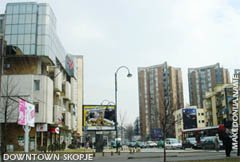 Being a seat, during the Second World War (1941-1945), Skopje became one of the first victim-cities, it was bombed by Fascist planes on April 6th, 1941, which resulted with 600 dead and 1,000 wounded. The next day, April 7th, units of the German occupation armies entered the city, followed by Bulgarian occupiers with their engines of denationalization. On October 11th, the very same year, 1941, the strong desire for freedom of the Macedonian people flared out more strongly than ever before. The rebellion had started in Prilep and Kumanovo. In a decisive struggle against all the enemies, diversions were organized in Skopje.
Being a seat, during the Second World War (1941-1945), Skopje became one of the first victim-cities, it was bombed by Fascist planes on April 6th, 1941, which resulted with 600 dead and 1,000 wounded. The next day, April 7th, units of the German occupation armies entered the city, followed by Bulgarian occupiers with their engines of denationalization. On October 11th, the very same year, 1941, the strong desire for freedom of the Macedonian people flared out more strongly than ever before. The rebellion had started in Prilep and Kumanovo. In a decisive struggle against all the enemies, diversions were organized in Skopje.
The First Skopje Partisan Detachment was formed immediately after the occupation, while during the war two Brigades. 5,000 inhabitants of the city lost their lives in the war, some as fighters and some as victims of Fascist terror. About 7,200 Jews were deported from Skopje and Macedonia on March 11th, 1943. They vanished forever in Treblinka and many other Fascist death camps. In the last autumn of the war the city dawned in freedom. The day to remember was November 13th, 1944. Immediately after the liberation, the Second Session of the Antifascist Assembly of National Liberation of Macedonia (ASNOM) was held in the liberated city. This session in Skopje, laid down the broad principles if the Macedonian Republic within the Yugoslav federal system.
:: SKOPJE AS A CAPITAL :::..
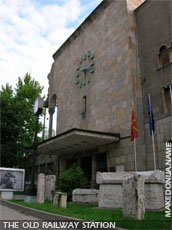 After the war, the city was chosen to be the capital of the Yugoslav Socialist Republic of Macedonia, and developed into an economic, administrative, cultural, religious, educational centre in the region. Skopje was one of the most beautiful cities in Yugoslavia until, the 26th of July 1963, date remembered as the longest day in the history of the city. Strong earthquake, of two severe and a few weaker shocks, turned the city into ruins. Before this date the city had 220,000 inhabitants. 80% of the city buildings and houses were demolished. [ read more ]
After the war, the city was chosen to be the capital of the Yugoslav Socialist Republic of Macedonia, and developed into an economic, administrative, cultural, religious, educational centre in the region. Skopje was one of the most beautiful cities in Yugoslavia until, the 26th of July 1963, date remembered as the longest day in the history of the city. Strong earthquake, of two severe and a few weaker shocks, turned the city into ruins. Before this date the city had 220,000 inhabitants. 80% of the city buildings and houses were demolished. [ read more ]
Numerous cultural monuments were seriously damaged or erased from the face of the earth. Skopje was rebuilt since then and the new residential quarters bear little resemblance with old Skopje. Many international architects participated in is reconstruction. According to the idea of the Japanese urban planner Kenzo Tanga, the center was given a "City Wall known on Macedonian known as Gradski Zid" of high - rise buildings up to 6 and 12 floors, while the banks of the Vardar were laid out as pleasant tree - lined promenades.
 The ancient trading quarter (čarsija) has been completely renovated, but has preserved all the notable features of its original architecture. In this setting the old buildings of cultural and historical interest are seen to even better advantage. They include the Kale fortress, the clock tower, Hjuncar mosque, Mustafa Pasha's mosque, Holy Saviour (Sveti Spas) church, and Daut Pasha's baths. While, the Army House, the church St. Constantine & Elena, the railway station were not renovated. The remains of the Jewish neighborhood in the downtown vanished forever. After the earthquake new and modern boulevards were built in order to connect the new settlements that were built, by donations of the International community. New settlement were raised up: Butel 1, Butel 2, Metodija Andonov-Čento, Avtokomanda, Lisiče, Aerodrom, Dračevo, Vlae 1, Vlae 2, Taftalizde 1, Taftalidze 2, Vodno, Kozle, Crniče, Pržino, Železara, Karpoš 3 and Karpoš 4. Skopje, due to the 1963 earthquake is known as a city of the International & World Wide solidarity.
The ancient trading quarter (čarsija) has been completely renovated, but has preserved all the notable features of its original architecture. In this setting the old buildings of cultural and historical interest are seen to even better advantage. They include the Kale fortress, the clock tower, Hjuncar mosque, Mustafa Pasha's mosque, Holy Saviour (Sveti Spas) church, and Daut Pasha's baths. While, the Army House, the church St. Constantine & Elena, the railway station were not renovated. The remains of the Jewish neighborhood in the downtown vanished forever. After the earthquake new and modern boulevards were built in order to connect the new settlements that were built, by donations of the International community. New settlement were raised up: Butel 1, Butel 2, Metodija Andonov-Čento, Avtokomanda, Lisiče, Aerodrom, Dračevo, Vlae 1, Vlae 2, Taftalizde 1, Taftalidze 2, Vodno, Kozle, Crniče, Pržino, Železara, Karpoš 3 and Karpoš 4. Skopje, due to the 1963 earthquake is known as a city of the International & World Wide solidarity.
Today Skopje it is the administrative, political and cultural centre of the Republic of Macedonia. The city is administrative divided on municipalities:
- Centar (settlements: Vodno, Debar Maalo, Bunjakovec, Kapištec)
- Aerodrom (settlements: Lisiče)
- Kisela Voda (settlements: Crniče, Pržino, Pripor, Dračevo, Pintija)
- Butel (settlements: Sever, Radišani)
- Čair (settlements: Old Bazzar, Bitpazar, Topaana, Topansko Pole)
- Gjorče Petrov (settlements: Novo Selo, Deksion)
- Karpoš (settlements: Taftalidze 1 and 2, Nerezi, Vlae 1, Vlae 2, Trnodol, Ždanec, Kozle, Hrom)
- Gazi Baba (settlements: Avtokomanda, Železara, Metodija Andovov - Čento, Madzari)
- Saraj (villages, Albanian majority municipality, attached to the city boundaries with political background, in order of increasing the procent of Albanian population up to 20%)
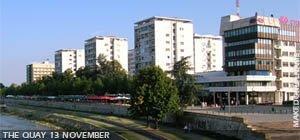
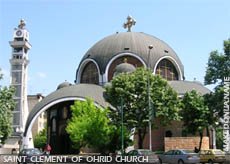 The biggest orthodox church, St. Clement was finished in 1990. The city today has 467,000 citizens, of which 65% are Macedonians, while the other 35% counts the ethnic Albanians, Turks, Serbs, Bosnians (Bosnjaks), Roma and others. The Roma people in Skopje have the largest neighborhood in Europe (16,000).
The biggest orthodox church, St. Clement was finished in 1990. The city today has 467,000 citizens, of which 65% are Macedonians, while the other 35% counts the ethnic Albanians, Turks, Serbs, Bosnians (Bosnjaks), Roma and others. The Roma people in Skopje have the largest neighborhood in Europe (16,000).
Bitpazar in downtown Skopje, is where Albanians live as a majority of the population and represents a red light district in the city (crime is very high in this area).
Industries in the city include iron and steel works, electrical machinery, chemicals, textiles, carpets, and foodstuffs. Skopje is a trading center for the cotton, tobacco, grains, and livestock produced in the surrounding region as well.
Besides the Belgrade - Athens highway and railway routes, the city also has the largest airport in the Republic of Macedonia. The Petrovec airport is just 17 km away from the city. You can reach Skopje by train, car or plane.
The first train that arrived in Skopje was the one, from Solun (Thessaloniki) in the distant year of 1873. Also this railway line, Salonica - Gevgelija - Veles - Skopje represents a part of the corridor Belgrade - Athens, is actually first railway in Macedonia.
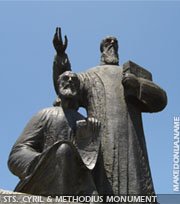 Skopje plays a vital part in the cultural and the academic life of the Republic of Macedonia. It is the home some educational institutes: Macedonian Academy of Science and Arts, the Saints Cyril and Methodius University, the National and University Library, FON College; home of some cultural institutes: the Macedonian National Theatre and it's Drama, Opera and Ballet companies, the Drama Theatre, the Theatre of Nationalities (Albanian & Turkish Drama), the Philharmonic of Macedonia, Macedonian Radio and Television and Nova Makedonija, the largest newspaper and publishing house, the Universal Hall (Univerzalna Sala). There are also the Archives of Macedonia, the Museums of Macedonia (archeological, ethnological and historical), the Natural history Museum, the Museum of Contemporary Art, several art galleries and other important cultural and scientific institutions.
Skopje plays a vital part in the cultural and the academic life of the Republic of Macedonia. It is the home some educational institutes: Macedonian Academy of Science and Arts, the Saints Cyril and Methodius University, the National and University Library, FON College; home of some cultural institutes: the Macedonian National Theatre and it's Drama, Opera and Ballet companies, the Drama Theatre, the Theatre of Nationalities (Albanian & Turkish Drama), the Philharmonic of Macedonia, Macedonian Radio and Television and Nova Makedonija, the largest newspaper and publishing house, the Universal Hall (Univerzalna Sala). There are also the Archives of Macedonia, the Museums of Macedonia (archeological, ethnological and historical), the Natural history Museum, the Museum of Contemporary Art, several art galleries and other important cultural and scientific institutions.
Also many cultural events occur in connection with the city: the "Skopje Jazz Festival", "Zlatna Bubamara", "12 Veličevstveni", The "TAKSIRAT", "Skopje Gori" and many others. The Governmental building and it's ministries, the Assembly of the Republic of Macedonia are settled in Skopje.

Since the year of 2000 the citizens of Skopje, from every part of the city can see the Millennium Cross, that symbolizes 2000 years of Christianity. It was built on top of the Vodno mountain, located south of Skopje, at an attitude of 1,066 meters above the sea level, with it's dimensions 66 and 20 meters. It is unique building in the world. There should be built a monastery complex in it's surroundings and a restaurant with a spectacular view of the city.
:: MONUMENTS :::..
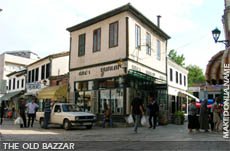 Old Skopje Bazaar: On the left side of the river Vardar, in the ancient part of Skopje is the old Skopje bazaar. Up to the present time the bazaar has experienced several changes in respect of the appearance and the organization, but it has still kept the spirit of the past. In the small innumerable handicraft shops, the Skopje's handicraftsmen can still be seen, tailors, cobbler, quilt makers, shoe makers, tinsmiths etc.
Old Skopje Bazaar: On the left side of the river Vardar, in the ancient part of Skopje is the old Skopje bazaar. Up to the present time the bazaar has experienced several changes in respect of the appearance and the organization, but it has still kept the spirit of the past. In the small innumerable handicraft shops, the Skopje's handicraftsmen can still be seen, tailors, cobbler, quilt makers, shoe makers, tinsmiths etc.
The old market place is still alive and full with a vivid atmosphere which radiates from the small shops, coffee and tea rooms which are always full with tourists which are delighted from the appearance and the life of this part of the city. Today most of these crafts are produced in factories, so only a few of the craftsmen remained keeping their jobs. Most of the shops here are for clothing, shoes, jewelries, restaurants, cafe-bars and tea-bars.
The Old Skopje Bazaar as a larger district include several cultural-historical monuments. Most of them are restored like: St. Spas church, Mustapha Pasha mosque, Čifte Amam, Daut Pasha Amam (amam-bath), Kapan An, Suli An, Kuršumli An (An-Inn). This district is one of the oldest in the city. Every corner here, tells his own history.
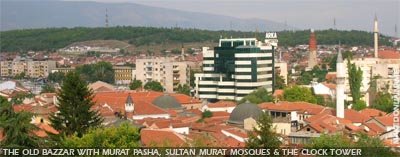
Clock Tower (Saat Kula): This monument is located on the "Krste Petkov-Misirkov" street, on a hill behind the "Sts. Cyril & Methodius University". It is a Turkish object, built east of the famous and oldest market place of Skopje, Bitpazar. It stands in the forecourt of Hjuncar - the mosque of Sultan Murat 2nd. It has a hexagonal foundation and has a different rooftop which resembles the numerous lateral domes of the new Moscow style of the Russian medieval architecture. This element had been previously employed by Mongolians.
The Clock Tower was built between 1566 AD and 1572 AD, most probably on the foundations of an already existing building. Initially, the upper part of the Tower was made of wood and the clock mechanism was brought from the city of Siged in Hungary. Writers that visited Skopje in the 16th and 17th centuries, noted that the Turks even brought a clock-master from Siged for the clock's maintenance. This was of great importance for the accurate performance of the five daily prayers. Many travelers mention the clock tower in their journals, as a large and important building in Skopje and add that its sound can be heard several kilometers away.
After the great fire in 1689, when the tower was seriously damaged it had to be repaired. Some alternations were made in 1902/3, a new top (made of Thessaloniki bricks) replaced the original wooden top of the clock, during the reign of Ali-Hivza Pasha. In addition, the clock mechanism was replaced with a new one, this time brought from Switzerland. During the 1963 earthquake, the clock tower was seriously damaged in addition to the Hjunkar mosque. The clock mechanism, was stolen during the 1963 earthquake and was replaced by no one, so far.
Sveta Bogorodica (Holy Mother of God): This church was built in 1835 and was main cathedral church in Skopje. It was also known as the protector of the city. The iconostasis was finished in 1842. On April 7th1944 the cathedral church, was burned down by the Bulgarian fascists. The entire iconostasis was burned, while important subjects were stolen and taken to Bulgaria. It's located on the Krste Misirkov bvd, opposite the Macedonian Academy of Science and Art (MANU). Today its in reconstruction.
Feudal Tower: Makes part of the House of ARM, the unique preserved monument in the new part of the city, by the monument of "Mother Teresa". The time when it was built and the one who built it are not known. Most probably it is a feudal tower of some Turkish bay. Today it is in good conditions.

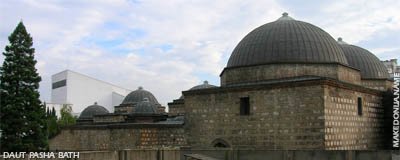
Daut Pasha's Bath: This project is one of the most prominent monuments of the Islamic profane architecture. The Turkish bath was built by the grand vizier of Rumelija, Daut Pasha in the 15th century. In the first time it was used for the needs of its harem, and later it served as a public bath. Today, the Turkish bath is turned into an art gallery with a wide choice of Macedonian icons of the 14th to the 19th century, collective works of Macedonian artists - pictures, sculptures, graphics, and drawings and more recently in the rooms of the Turkish bath also concerts are held, promotions of books, theater performances with chamber orchestra etc.
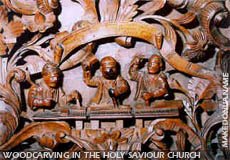 Holy Savior Church: (also known as Sveti Spas) It was built in the beginning of the 17th or 18th century, upon foundations on an older church. Part of the fresco painting on the southern side was found from this older church which origins from 16th century. In contrast to the modest outside appearance of the church, after one enters inside, he immediately becomes astonished in front of the beauty of the iconostasis on the eastern side. The 19th century iconostasis of the church of the Holy Savior, carved in walnut, combines a profusion of plant and animal motifs with the figures of saints in local costumes. This realistic high-relief carving is the work of skilful craftsmen of the Debar area, who included their own figures in one corner of the iconostasis. The iconostasis is 6 meters high and 10 meters long. On this space, the carving group managed to show numerous scenes from the bible, important geometrical ornaments and figures from the flora and the fauna. The iconostasis at this church is one of the finest samples of traditional woodcarving which can be found on the territory of the Republic of Macedonia along with the iconostasis of St. Jovan Bigorski Monastery. Goce Delčev, the well known Macedonian revolutionary organizer is buried in the yard of this church.
Holy Savior Church: (also known as Sveti Spas) It was built in the beginning of the 17th or 18th century, upon foundations on an older church. Part of the fresco painting on the southern side was found from this older church which origins from 16th century. In contrast to the modest outside appearance of the church, after one enters inside, he immediately becomes astonished in front of the beauty of the iconostasis on the eastern side. The 19th century iconostasis of the church of the Holy Savior, carved in walnut, combines a profusion of plant and animal motifs with the figures of saints in local costumes. This realistic high-relief carving is the work of skilful craftsmen of the Debar area, who included their own figures in one corner of the iconostasis. The iconostasis is 6 meters high and 10 meters long. On this space, the carving group managed to show numerous scenes from the bible, important geometrical ornaments and figures from the flora and the fauna. The iconostasis at this church is one of the finest samples of traditional woodcarving which can be found on the territory of the Republic of Macedonia along with the iconostasis of St. Jovan Bigorski Monastery. Goce Delčev, the well known Macedonian revolutionary organizer is buried in the yard of this church.
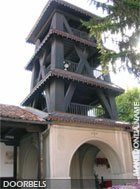
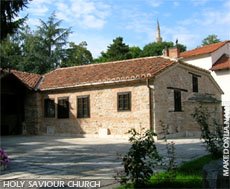
St. Pantelejmon Monastery: This famous church, is located in the vicinity of the Gorno Nerezi village, on the Vodno Mountain, where Skopje can be seen on a hand. This church dates back from the 12th century, from the year of 1164 (the Byzantine period). The church interior is decorated with frescoes of exceptional artistic value. [ Read more ]
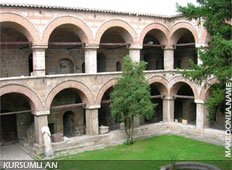 Kuršumli An: In the sources, Kuršumli An is mentioned as a memorial of Mula Musledin Hodza. Kuršumli An acts impressively and delightfully with its monumentality, decoratively built walls and the numerous domes in shape of pyramids. Today, the complex of the Museum of Macedonia is located within the Turkish bath. The yard of Kuršumli An during the summer period is being used for organizing of cultural manifestations: dramatic performances, concerts, literature readings…
Kuršumli An: In the sources, Kuršumli An is mentioned as a memorial of Mula Musledin Hodza. Kuršumli An acts impressively and delightfully with its monumentality, decoratively built walls and the numerous domes in shape of pyramids. Today, the complex of the Museum of Macedonia is located within the Turkish bath. The yard of Kuršumli An during the summer period is being used for organizing of cultural manifestations: dramatic performances, concerts, literature readings…
The Aqueduct: On 2 kilometers north-west from Skopje, the aqueduct was built of stone and bricks with 55 arches supported on massive pillars. For the building of the aqueduct there were shared opinions in the science. According some scientists it was a Roman aqueduct whereas according to others it was a Byzantium building. The last scientific researches connect the building of the aqueduct with Isa bey, which means that it was built during the time of the Turkish rule and more precisely in 16th century. Aqueducts in former Yugoslavia were only 3, one in Macedonia and two in Montenegro.
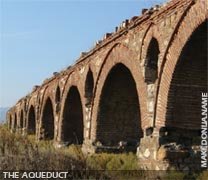

The Stone Bridge: According to certain data the bridge was built in the 6th century, whereas in its present form it was raised upon the old foundation in the time of the Sultan Murat 2nd in the first half of the 15th century. It was built of well worked out stone blocks and has 12 semicircular arches. This monumental building has undergone larger repairs through the centuries, but today the bridge has still kept the primary shape and form.

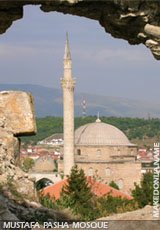 The Kale Fortress: This fortress has the dominant place in the city. It was built of stone blocks from the ruins of the city of Scupi, during the rule of the Byzantium Emperor Justinijan the 1st. The ramparts of the Skopsko Kale are 121 meter long and today one square, one rectangular and one round tower are saved. It originates from the 6th century, while it's presents appearance is from the Ottoman period.
The Kale Fortress: This fortress has the dominant place in the city. It was built of stone blocks from the ruins of the city of Scupi, during the rule of the Byzantium Emperor Justinijan the 1st. The ramparts of the Skopsko Kale are 121 meter long and today one square, one rectangular and one round tower are saved. It originates from the 6th century, while it's presents appearance is from the Ottoman period.
The great complex since 1392 was stationary of the Turkish army until 1913, when Skopje falls under Serbian authority. And in the period from 1913 to 1953 here was settled the Yugoslav army. Today in the space of the fortress is an arranged park, which serves for recreation and fun, and in the evening hours besides the sounds of the Macedonian folks music, the visitors have a wonderful view on the city and the river Vardar from there.
Mustafa Pasha's Mosque: In the vicinity of Kuršumli-an, in the old part of the city this monument of the Islamic culture attracts the attention with its size and beauty. The mosque was built by Mustafa Pasha in 1519, the vizier of the Sultan Selim 1st. Particularly attractive part of this building is the tall minaret, made of cut stone, whereas the expanded part is decorated with ornaments.